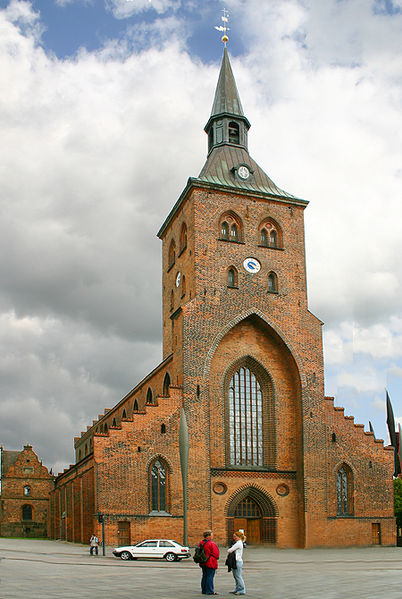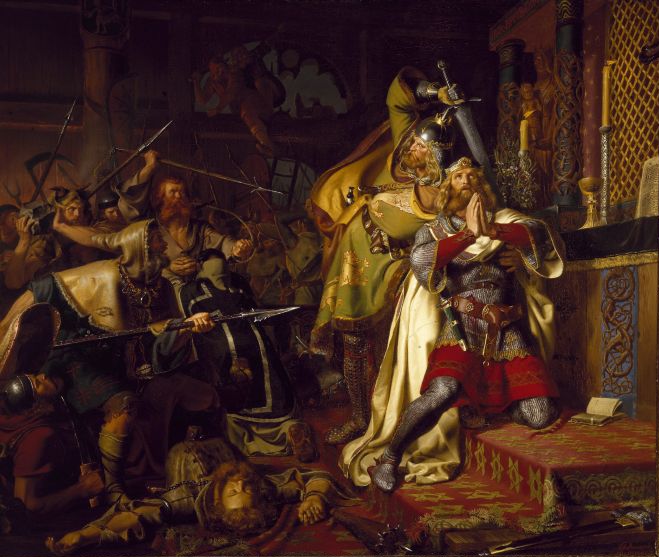Textiles in 11th century crypt reveal the thread of events long past, says S.Ananthanarayanan.
Science often ties up loose ends that historical records cannot bring together.
Poul Grinder‑Hansen, Ulla Kjaer Morten Ryhl‑Svendsen, Maria Perla Colombini, Ilaria Degano, Jacopo La Nasa , Francesca Sabatini, Johannes van der Plicht and Kaare Lund Rasmussen, of National Museum of Denmark and Royal Danish Academy of Fine Arts, Copenhagen, Università Di Pisa, Italy, Center for Isotope Research, Groningen and Leiden University, The Netherlands, and University of Southern Denmark, Odense, describe in the journal, Heritage Science, their work on the contents of an 11th Century, Danish crypt, which resolves a question of the antiquity of its contents.
The crypt in question is in St Canute's Cathedral, in Odense, in Denmark and it houses two 1.5 metre-long wooden coffins, or the shrines, with the remains of the Danish king, Canute the holy, approx. 1040 -1086, and his younger half-brother, Benedikt. The coffins, over centuries, had been stripped of their original ornamentation and there was need to keep them hidden. When they were finally discovered, in 1694, they were found stored upright, with the bones, and the cloth that had covered them, in a heap at the bottom.

The paper in Heritage Science recounts the history of Danish royal saint. King Canute IV, or Canute the Holy or St Canute, was one of the many sons of King Svend Estridsen, who reigned in Denmark around 1047-1074. When he died, five sons, one after another, became king, and King Canute was the second in the line. "His ideal was that of a strong royal power and his attempts to realize it in cooperation with the Church made him many enemies," the paper says. The result was that in July 1086, King Canute and his brother were killed, with seventeen others. As the king had taken refuge in St Alban's Church, in Odense, when he was hunted down, he had been killed on holy ground, a fact that helped remaining members of the royal family, in 1101, to have king Canute cannonised, as Saint Canute.

As the remains of a saint, king Canute's bones were moved to a stone coffin below a new church being built in his honour, and then to an ornamented container in the newly built St Canute's Church. The paper cites records that say, "The royal bones were wrapped in silk and placed in a marvelous shrine forged of yellow shining metal and decorated by precious blue and yellow stones." There were other references, from time to time, that the shrine was venerated, placed on an alter and displayed, and taken out in procession in the town of Odense, in connection with the saint's day of martyrdom in July.
There are other records, the paper says, of demands from rebel leaders and from the king, for taxes and levies, and a mention, in 1536, of the monastery of St Canute having drawn on the silver from a shrine in the church to meet the dues. There are further references, possibly to the same crypt, when the church was rebuilt, in 1582, and in in writings, and visits by foreign Catholics, including one in 1622. And then, in 1694, when the shrines were found again in a recess in the wall, and there is a description of the state of the shrines and their contents.
It was in 1833, the paper says, that the shrines were fitted with new glass lids and properly displayed. More important, the paper says, the textiles, which were rich and rare silks, were taken out and moved to the National Museum in Copenhagen. Again, in 1875, the shrines, bones and cloth were restored and the cloth, which was considered fragile, was described in detail. And in modern times, recognizing the effects of humidity and exposure, the relics are preserved in specially designed showcases.
As a result of the 'chaotic' movement and handling of the relics, even before 1833, there has been some uncertainty about their identity and antiquity. There are suggestions that the bones are of a nephew of King Canute and that the textiles were added later. Whether the dates assigned to the bones and the wood are reliable, and whether the textiles in the shrine are authentic, are questions to be answered the paper says. And then, of the environment within the glass cases - how well the contents are conserved and the possibility of contaminants, which may have even affected the radiocarbon dating.
The current investigation used sensitive chemical analyses and radiocarbon dating using the method of Accelerator Mass Spectroscopy (AMS). Radiocarbon dating depends on the fact that the carbon atoms consist in different forms, for the most part in a form called 12C, or atoms that have 12 particles in the nucleus, and for a miniscule part, in a form called 14C, where the nucleus has 14 particles. Now, the 14C part is radioactive, which is to say, it decays, and its presence in a sample would reduce with time. The ratio of the two kinds of carbon, however, have stabilised, so that processes that give rise to 14C just compensate the rate of decay, and the 14C component of carbon is constant.
This is true so long as the carbon is part of nature and the part that decays is being replenished. If the carbon is fixed in a piece of cloth, or in bones when the body dies, or wood, when a tree is cut, however, the 14C content reduces with time. As 14C is radioactive, we can measure the activity and assess how much 14C there is left, and hence the age of the sample.
This is the conventional method of radiocarbon dating, which is useful to date the wood in ancient ruins, remains of animals, organic matter in artifacts or isolated geological samples. The trouble is that the method needs a reasonable quantity- 10 grams of wood or charcoal and 100 grams of bones and sediments - of the material to be dated. In AMS, on the other hand, the level of 14C is detected directly. The carbon in a tiny sample - as low as 20 milligrams - is extracted and irradiated with cesium ions. This generates carbon ions, or negatively charged carbon atoms, which are accelerated by an electric field. When a beam of speeding carbon ions is deflected by a magnetic field, the deflection depends on the mass, and the 14C ions separate from the 12C (and 13C) ions and the dating can be more precise.
AMS established the dates of textiles as 1045-1155- a wide range, but it shows that all nine pieces of cloth were manufactured close to the date, 1100, of enshrinement. Radiocarbon dating of the bones again match the year, 1086, of the death of King Canute and his half-brother. Analysis of the wood similarly shows that the timber was harvested around the 1100.
As for the protection that the relics, through the action taken in 1833, or the current methods, the analyses of the air surrounding the relics, as well as the exchange with the environment indicates that it can be improved. That the relics are in sealed containers saves them from the environment, but the decay of the oak wood releases substances that could affect all the objects being displayed.
------------------------------------------------------------------------------------------ Do respond to : response@simplescience.in-------------------------------------------